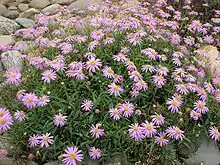Brachyscome
Brachyscome is a genus of flowering plants in the aster family, Asteraceae. Most are endemic to Australia, and a few occur in New Zealand and New Guinea.[1]
| Brachyscome | |
|---|---|
 | |
| Brachyscome graminea | |
| Scientific classification | |
| Kingdom: | |
| (unranked): | |
| (unranked): | |
| (unranked): | |
| Order: | |
| Family: | |
| Subfamily: | |
| Tribe: | |
| Genus: | Brachyscome |
| Species | |
Name
The genus name is spelled Brachycome by some authors. Henri Cassini published the name Brachyscome in 1816, forming it from the classical Greek brachys ("short") and kome ("hair"), a reference to the very short pappus bristles. Because the combining form of brachys in Greek compound words is brachy-, Cassini later corrected the spelling to Brachycome. Australian taxonomists still debate whether Cassini's corrected spelling is admissible under the rules of botanical nomenclature. A proposal to conserve Brachycome was rejected in 1993 by the Committee for Spermatophyta.[2]
Genetics
One of the annual plains species, Brachyscome dichromosomatica, is remarkable for its low chromosome count. In this species n=2, though some plants have 1, 2 or 3 additional large B chromosomes.[3] The genus has an unusually large range of chromosome counts, from n=2 to n=18.[4]
Description
These are annual and perennial herbs and small shrubs. Species have a basal rosette of leaves and/or leaves alternately arranged on the stem. The blades are entire or divided. The flower heads are solitary or borne in small corymbs. The head has a row of ray florets in shades of white, blue, pink, or mauve, and yellow disc florets.[1]
Fruit
The genus is distinguished from other genera in tribe Astereae mainly by the structure of the fruit. These achenes or cypselas are roughly club-shaped but usually incurved and flattened. They often have a membranous rim or wing around the edge that is sometimes wavy or fringed. The pappus is less than one millimeter long in most species.[5]
Habitat
Brachyscome species are found in a wide range of habitats. They occupy rainy coastal and mountainous regions as well as dry central Australia.[4]
Cultivation
Some Brachyscome species, notably Brachyscome iberidifolia (Swan river daisy), are popular as easily cultivated ornamental plants for flower gardens, and many cultivars are bred for their form, foliage, and flowers.[6]
Species
There are between 65 and 80 species in the genus.[1][4][7]
Species include:
- Brachyscome chrysoglossa - yellow-tongue daisy
- Brachyscome ciliaris - variable daisy
- Brachyscome graminea - stiff daisy, grassland daisy
- Brachyscome iberidifolia - Swan River daisy
- Brachyscome multifida - cut-leaved daisy, rock daisy, Hawkesbury daisy
- Brachyscome scapigera - tufted daisy
- Brachyscome segmentosa - Lord Howe daisy, mountain daisy
References
- Genus Brachyscome. PlantNet. New South Wales Flora Online. The Royal Botanic Gardens and Domain Trust, Sydney.
- Brummitt, R. K. (1993). Report of the Committee for Spermatophyta: 38. Taxon 42(3), 687-97.
- Carter, C. R. (1978). Taxonomy of the Brachycome lineariloba complex (Asteraceae). Telopea 5, 387-93.
- Watanabe, K., et al. (1999). Chromosomal evolution in the genus Brachyscome (Asteraceae, Astereae): statistical tests regarding correlation between changes in karyotype and habit using phylogenetic information. Journal of Plant Research 112(2), 145-61.
- Everett, J. "Brachycome". In: Harden, G. J. (ed.) Flora of New South Wales volume 3, pages 155-67. University of New South Wales Press. 1992.
- Research Garden. Royal Botanic Gardens, Cranbourne.
- Brachyscome. The Plant List.
External links
| Wikimedia Commons has media related to Brachyscome. |
- Brachyscome species records. FloraBase. Western Australian Herbarium.
Further reading
- Watanabe, K. and P. S. Short. (1992). Chromosome number determinations in Brachyscome. Muelleria 7, 451–71.